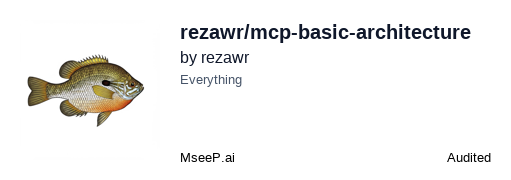About
A clean, extensible MCP server that registers tools and resources for LangGraph workflows, enabling easy addition of new functionality while maintaining clear separation of concerns.
Capabilities

Overview of the LangGraph MCP Server
The LangGraph MCP server is a clean, modular implementation designed to expose the capabilities of LangGraph through the Model Context Protocol. By serving as a bridge between AI assistants and external data or tools, it solves the problem of tight coupling that often plagues AI integrations. Developers can now register new functionalities—whether they are computational tools, data resources, or custom prompts—without touching the core server logic. This abstraction allows AI assistants to discover and invoke capabilities dynamically, fostering a more flexible and extensible workflow.
Core Value for AI Developers
At its heart, the server provides a single entry point that initializes the MCP stack and automatically registers all available tools and resources. For developers, this means:
- Rapid iteration: Add a new weather‑forecast tool or a database query resource, and the server immediately makes it available to any connected AI client.
- Decoupled evolution: The core server remains unchanged while new features grow in separate modules, reducing merge conflicts and easing version control.
- Consistent interface: All tools and resources follow the same registration pattern, ensuring predictable behavior across different modules.
Key Features Explained
- Modular Directory Structure: Separate folders for configuration, tools, resources, and utilities keep responsibilities clear. Each component can be developed, tested, or replaced independently.
- Tool Registration API: Developers define functions and register them with decorators (e.g., ). These become callable actions that an AI assistant can invoke via MCP.
- Resource Registration API: Data sources are exposed through URI schemes (e.g., ). Clients can fetch structured data without needing to know the underlying implementation.
- Centralized Configuration: A single holds environment variables, server ports, and other settings, simplifying deployment across environments.
- Utility Layer: Shared helpers like logging utilities keep boilerplate out of the main logic, improving readability.
Real‑World Use Cases
- Dynamic Knowledge Retrieval: An AI assistant can query the server for real‑time weather, stock prices, or internal company data by calling registered resources.
- Automated Workflow Orchestration: Tools such as or custom LangGraph functions can be chained together by an assistant to complete multi‑step tasks.
- Rapid Feature Rollout: New analytical tools (e.g., sentiment analysis, data summarization) can be added and instantly made available to all clients without redeploying the entire system.
- Scalable Service Architecture: As more tools and resources are added, the server’s modular design prevents performance bottlenecks or maintenance headaches.
Integration with AI Workflows
The server fits seamlessly into existing MCP‑enabled pipelines. An AI assistant discovers available tools and resources through the protocol’s discovery endpoints, then calls them as needed during a conversation or task. Because tools are pure functions and resources expose structured data, the assistant can compose complex behaviors—such as fetching a forecast, analyzing it with a LangGraph flow, and summarizing the result—all while maintaining statelessness between calls. This pattern encourages low‑coupling, high‑cohesion interactions that are easier to test and audit.
Standout Advantages
- Clean Architecture: The separation of concerns makes the codebase approachable for new contributors and reduces technical debt.
- Extensibility without Complexity: Adding a tool or resource requires only creating a file and registering it; no changes to the core server are needed.
- Built‑for‑Testing: Each component can be unit‑tested in isolation, ensuring reliability as the system scales.
- Future‑Proof: The design anticipates growth—additional protocols, authentication layers, or advanced resource types can be integrated with minimal disruption.
In summary, the LangGraph MCP server provides a robust, developer‑friendly foundation for exposing AI‑ready capabilities. Its modular design, clear registration patterns, and alignment with MCP principles enable teams to iterate quickly while maintaining a clean, maintainable codebase.
Related Servers
MarkItDown MCP Server
Convert documents to Markdown for LLMs quickly and accurately
Context7 MCP
Real‑time, version‑specific code docs for LLMs
Playwright MCP
Browser automation via structured accessibility trees
BlenderMCP
Claude AI meets Blender for instant 3D creation
Pydantic AI
Build GenAI agents with Pydantic validation and observability
Chrome DevTools MCP
AI-powered Chrome automation and debugging
Weekly Views
Server Health
Information
Explore More Servers
Taskqueue MCP
AI‑powered task management with approval checkpoints
Todoist MCP Server
Natural Language Task Management for Todoist
Buttplug MCP Server
LLM-controlled buttplug.io device manager
Time MCP Server
Enabling AI assistants to handle time and date operations
QGIS MCP Server
AI‑powered QGIS automation via Claude
JobsWithGPT MCP Server
AI-powered job search via conversational agents